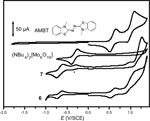Publication
663
Eur. J.,
16, 8390 -8399, 2010.
DOI: 10.1002/chem.201000427
|
|
|
|
|
 |
Electroactive Benzothiazole Hydrazones and Their [Mo6O19]2- Derivatives: Promising Building Blocks for Conducting Molecular Materials |
|
|
|
|
Sylvain Gatard, Sébastien Blanchard, Bernd Schollhorn, Pierre Gouzerh, Anna Proust, Kamal Boubekeur
Institut Parisien de Chimie Moléculaire, UMR CNRS 7201, UPMC Université Paris 06, Case courrier 42, 4 place Jussieu, 75252 Paris Cedex 05 (France) )
Institut Universitaire de France, 103, bd. Saint-Michel, 75005 Paris (France)
Laboratoire d'Electrochimie Moléculaire, UMR CNRS 7591, Université Paris Diderot Paris 7, Bâtiment Lavoisier, Case 7107, 15 rue Jean-Antoine de Baïf, 75205 Paris Cedex 13 (France)
The electroactive benzothiazole hydrazone AMBTH-H2, a new member of the 2,2´-azino-bis(N-alkylbenzothiazole) family, was synthesised in a five-step procedure and characterised by using X-ray diffraction along with two intermediates and the N-methylbenzothiazole hydrazone MBTH-H2. Both AMBTH-H2 and MBTH-H2 were coupled to [Mo6O19]2- in acetonitrile in the presence of dicyclohexylcarbodiimide and dimethylaminopyridine to give two new diazoalkane-hexamolybdates, which were isolated as tetrabutylammonium salts and characterised by using IR, UV/Vis and NMR spectroscopies, cyclic voltammetry and, for one of them, X-ray diffraction. The packing arrangement molecules in crystals of AMBTH-H2, the redox features of the AMBTH-hexamolybdate hybrid together with a good electronic communication between the organic  system and the molybdenum centres make these compounds very promising blocks for the synthesis of conducting molecular materials. system and the molybdenum centres make these compounds very promising blocks for the synthesis of conducting molecular materials. |

